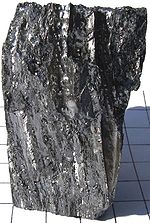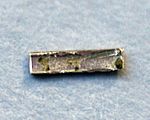- Alkaline earth metal
-
Group 2 Period 2 
4
Be3 
12
Mg4 
20
Ca5 
38
Sr6 
56
Ba7 
88
RaThe alkaline earth metals are a group in the periodic table. In the modern IUPAC nomenclature, the alkaline earth metals are called the group 2 elements. Previously, they were called the Group IIA elements (pronounced "group two A", as the "II" here is a Roman numeral). The alkaline earth metals contain beryllium (Be), magnesium (Mg), calcium (Ca), strontium (Sr), barium (Ba) and radium (Ra).[1] (Although helium (He) is occasionally considered to be a group 2 element, for example, in the extended periodic table and Janet periodic table, it never exhibits behaviour comparable to the alkaline earth metals.) The group lies in the s-block of the periodic table.
This specific group in the periodic table owes its name to their oxides that simply give basic alkaline solutions. These oxides melt at such high temperature that they remain solids ("earths") in fires. The alkaline earth metals provide a good example of group trends in properties in the periodic table, with well-characterized homologous behavior down the group. With the exception of beryllium and magnesium, the metals have a distinguishable flame color, orange for calcium, bright red for strontium, green for barium and crimson red for radium.
All of the alkaline earth metals discovered, as of 2011, are naturally occurring (see abundance of the chemical elements for references), and share similar properties: they are all rather reactive metals under standard conditions. So far, experiments have been conducted to attempt the synthesis of the next member of the group, unbinilium (Ubn), but these have all met with failure. However, since unbinilium is the second period 8 element and only the second element on the periodic table that has not been discovered yet, it is likely to be discovered in the near future. It is also possible that ununhexium (Uuh), which has been synthesised in 2002, is the next alkaline earth metal.
Like other groups, the members of this family show patterns in its electron configuration, especially the outermost shells resulting in trends in chemical behavior:
Z Element No. of electrons/shell 4 Beryllium 2, 2 12 Magnesium 2, 8, 2 20 Calcium 2, 8, 8, 2 38 Strontium 2, 8, 18, 8, 2 56 Barium 2, 8, 18, 18, 8, 2 88 Radium 2, 8, 18, 32, 18, 8, 2 The alkaline earth metals are silver colored, soft metals, which react readily with halogens to form ionic salts, and with water, though not as rapidly as the alkali metals, to form strong alkaline (basic) hydroxides. For example, where lithium, sodium and potassium react with water at room temperature, magnesium reacts only with steam and calcium with hot water:
- Mg + 2 H2O → Mg(OH)2 + H2
Beryllium is an exception: It does not react with water or steam, and its halides are covalent.
All the alkaline earth metals have two electrons in their valence shell, so the energetically preferred state of achieving a filled electron shell is to lose two electrons to form doubly charged positive ions.
The alkaline earth metals are named after their oxides, the alkaline earths, whose old-fashioned names were beryllia, magnesia, lime, strontia and baryta. These oxides are basic (alkaline) when combined with water. "Earth" is an old term applied by early chemists to nonmetallic substances that are insoluble in water and resistant to heating—properties shared by these oxides. The realization that these earths were not elements but compounds is attributed to the chemist Antoine Lavoisier. In his Traité Élémentaire de Chimie (Elements of Chemistry) of 1789 he called them salt-forming earth elements. Later, he suggested that the alkaline earths might be metal oxides, but admitted that this was mere conjecture. In 1808, acting on Lavoisier's idea, Humphry Davy became the first to obtain samples of the metals by electrolysis of their molten earths.
Contents
Biological occurrences
- Beryllium's low aqueous solubility means it is rarely available to biological systems; it has no known role in living organisms, and when encountered by them, is generally highly toxic.
- Magnesium and calcium are ubiquitous and essential to all known living organisms. They are involved in more than one role, with, for example, Mg/Ca ion pumps playing a role in some cellular processes, magnesium functioning as the active center in some enzymes, and calcium salts taking a structural role (e.g. bones).
- Strontium and barium have a lower availability in the biosphere. Strontium plays an important role in marine aquatic life, especially hard corals. They use strontium to build their exoskeleton. These elements have some uses in medicine, for example "barium meals" in radio graphic imaging, whilst strontium compounds are employed in some toothpastes.
- Radium has a low availability and is highly radioactive, making it toxic to life.
Comparison of the physical properties and chemical properties between alkaline earth and alkali metals
Just like their names, they do not differ completely. The main difference is the electron configuration, which is ns2 for alkaline earth metals and ns1 for alkali metals. For the alkaline earth metals, there are two electrons that are available to form a metallic bond, and the nucleus contains an additional positive charge. Also, the elements of group 2A (alkaline earth) have much higher melting points and boiling points compared to those of group 1A (alkali metals). The alkali also have a softer and more lighweight figure whereas the alkaline earth metals are much harder and denser.
The second valence electron is very important when it comes to comparing chemical properties of the alkaline earth and the alkali metals. The second valence electron is in the same “sublevel” as the first valence electron. Therefore, the Zeff is much greater. This means that the elements of the group 2A contain a smaller atomic radius and much higher ionization energy than the group 1A. Even though the group 2A contains much higher ionization energy, they still form an ionic compound with 2+ cations. Beryllium, however, behaves differently. This is because in order to remove two electrons from this particular atom, it requires significantly more energy. It never forms Be2+ and its bonds are polar covalent.
Beryllium
As mentioned earlier, Be is “special”; it behaves differently. If the Be2+ ion did exist, it would polarize electron clouds that are near it very strongly and would cause extensive orbital overlap, since Be has a high charge density. All compounds that include Be have a covalent bond. Even the compound BeF2 , which is the most ionic Be compound, has a low melting point and a low electrical conductivity when melted.
Important reactions and compounds
Reactions:
Note: E = elements that act as reducing agents
1. The metals reduce halogens to form ionic halides: E(s) + X2 → EX2 (s) where X = F, Cl, Br or I
2. The metals reduce O2 to form the oxides: 2E(s) + O2 → 2EO(s)
3. The larger metals react with water to produce hydrogen gas: E(s) + 2H2O(l) → E2+(aq) + 2OH-aq + H2 (g) where E = Ca, Sr or Ba
Compounds
1. Alkylmagnesium halides (RMgX where R = hydrocarbon group and X = halogen). They are used to synthetise organic compounds.
Here’s an example: 3RMgCl + SnCl4 → 3MgCl2 + R3SnCl
2. Magnesium oxide (MgO). It is used as a material to refract furnace brick and wire insulation (melting point of 2852°C).
3. Calcium carbonate (CaCO3). It is mainly used in the construction industry and for making limestone, marble, chalk, and coral.References
- ^ Nomenclature of Inorganic Chemistry. IUPAC Recommendations 2005. International Union of Pure and Applied Chemistry. 2005. p. 51. http://old.iupac.org/publications/books/rbook/Red_Book_2005.pdf.
- Group 2 - Alkaline Earth Metals, Royal Chemistry Society.
- Group 1 Alkali Metals and Group 2 Alkaline Earth Metals, Doc Brown's Chemistry Clinic.
- Science aid: Group 2 Metals Study aid for teens
- Hogan, C.Michael. 2010. Calcium. eds. A.Jorgensen, C. Cleveland. Encyclopedia of Earth. National Council for Science and the Environment.
- Maguire, Michael E. "Alkaline Earth Metals." Chemistry: Foundations and Applications. Ed. J. J. Lagowski. Vol. 1. New York: Macmillan Reference USA, 2004. 33-34. 4 vols. Gale Virtual Reference Library. Thomson Gale.
- Silberberg, M.S., Chemistry: The molecular nature of Matter and Change (3e édition, McGraw-Hill 2009)
- Petrucci R.H., Harwood W.S. et Herring F.G., General Chemistry (8e édition, Prentice-Hall 2002)
Explanation of above periodic table slice: Alkaline earth metals Atomic numbers in black indicate solids Solid borders indicate primordial elements (older than the Earth) Dashed borders indicate natural radioactive elements with no isotopes older than the Earth Periodic tables Layouts - Standard
- Large table
- Inline f-block
- Vertical
- Text only
- Metals and nonmetals
- Blocks
- Valences
- Extension beyond the 7th period
- Large extended table
- Electron configurations
- Electronegativities
- Alternatives
- Crystal structure
- Discovery periods
List of elements by - Name etymology (symbol)
- Discovery
- Oxidation state
- Abundance (in humans)
- Nuclear stability
- Hardness
- Atomic properties
- Production
Groups - 1 (Alkali metals)
- 2 (Alkaline earth metals)
- 3
- 4
- 5
- 6
- 7
- 8
- 9
- 10
- 11
- 12
- 13 (Boron group)
- 14 (Carbon group)
- 15 (Pnictogens)
- 16 (Chalcogens)
- 17 (Halogens)
- 18 (Noble gases)
Other element categories - Periods
- Metals
- Transition metals
- Metalloids
- Nonmetals
- Lanthanides
- Actinides
- Rare earth elements
- Platinum group metals (PGMs)
- Post-transition metals
- Refractory metals
Blocks Periods Periodic table H He Li Be B C N O F Ne Na Mg Al Si P S Cl Ar K Ca Sc Ti V Cr Mn Fe Co Ni Cu Zn Ga Ge As Se Br Kr Rb Sr Y Zr Nb Mo Tc Ru Rh Pd Ag Cd In Sn Sb Te I Xe Cs Ba La Ce Pr Nd Pm Sm Eu Gd Tb Dy Ho Er Tm Yb Lu Hf Ta W Re Os Ir Pt Au Hg Tl Pb Bi Po At Rn Fr Ra Ac Th Pa U Np Pu Am Cm Bk Cf Es Fm Md No Lr Rf Db Sg Bh Hs Mt Ds Rg Cn Uut Uuq Uup Uuh Uus Uuo Alkali metals Alkaline earth metals Lanthanides Actinides Transition metals Other metals Metalloids Other nonmetals Halogens Noble gases Unknown chem. properties Large version Alkaline earth metals Beryllium
Be
Atomic Number: 4
Atomic Weight: 9.012182
Melting Point: 1560.15 K
Boiling Point: 2742 K
Specific mass: 1.85 g/cm3
Electronegativity: 1.57Magnesium
Mg
Atomic Number: 12
Atomic Weight: 24.3050
Melting Point: 923.15 K
Boiling Point: 1363 K
Specific mass: 1.738 g/cm3
Electronegativity: 1.31Calcium
Ca
Atomic Number: 20
Atomic Weight: 40.078
Melting Point: 1112.15 K
Boiling Point: 1757 K
Specific mass: 1.54 g/cm3
Electronegativity: 1Strontium
Sr
Atomic Number: 38
Atomic Weight: 87.62
Melting Point: 1042.15 K
Boiling Point: 1655 K
Specific mass: 2.64 g/cm3
Electronegativity: 0.95Barium
Ba
Atomic Number: 56
Atomic Weight: 137.327
Melting Point: 1002.15 K
Boiling Point: 2170 K
Specific mass: 3.594 g/cm3
Electronegativity: 0.89Radium
Ra
Atomic Number: 88
Atomic Weight: 226
Melting Point: 973.15 K
Boiling Point: 2010 K
Specific mass: 5.5 g/cm3
Electronegativity: 0.9Categories:- Periodic table
- Alkaline earth metals
Wikimedia Foundation. 2010.

